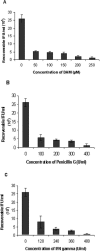Transcriptional response patterns of Chlamydophila psittaci in different in vitro models of persistent infection
- PMID: 16861668
- PMCID: PMC1539575
- DOI: 10.1128/IAI.01487-05
Transcriptional response patterns of Chlamydophila psittaci in different in vitro models of persistent infection
Abstract
The obligatory intracellular bacterium Chlamydophila psittaci is the causative agent of psittacosis in birds and humans. The capability of this zoonotic pathogen to develop a persistent phase is likely to play a role in chronicity of infections, as well as in failure of antibiotic therapy and immunoprophylaxis. To elucidate three different in vitro models for transition of C. psittaci to persistence (iron depletion, penicillin G treatment, and gamma interferon [IFN-gamma] exposure), a set of 27 genes was examined by mRNA expression analysis using quantitative real-time PCR. While the phenotypical characteristics were the same as in other chlamydiae, i.e., aberrant morphology of reticulate bodies, loss of cultivability, and rescue of infectivity upon removal of inducers, the transcriptional response of C. psittaci to persistence-inducing factors included several new and distinctive features. Consistent downregulation of membrane proteins, chlamydial sigma factors, cell division protein, and reticulate body-elementary body differentiation proteins from 24 h postinfection onward proved to be a general feature of C. psittaci persistence. However, other genes displayed considerable variations in response patterns from one model to another, which suggests that there is no persistence model per se. In contrast to results for Chlamydia trachomatis, late shutdown of essential genes in C. psittaci was more comprehensive with IFN-gamma-induced persistence, which is probably due to the absence of a functional tryptophan synthesis operon.
Figures




References
Publication types
MeSH terms
Substances
LinkOut - more resources
Full Text Sources
Other Literature Sources

